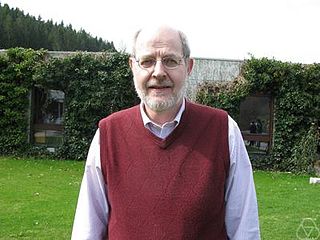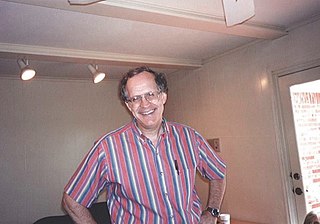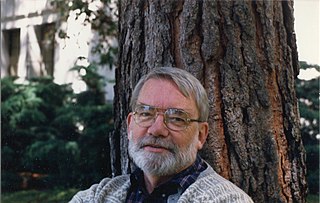Related Research Articles
Noncommutative geometry (NCG) is a branch of mathematics concerned with a geometric approach to noncommutative algebras, and with the construction of spaces that are locally presented by noncommutative algebras of functions, possibly in some generalized sense. A noncommutative algebra is an associative algebra in which the multiplication is not commutative, that is, for which does not always equal ; or more generally an algebraic structure in which one of the principal binary operations is not commutative; one also allows additional structures, e.g. topology or norm, to be possibly carried by the noncommutative algebra of functions.
Errett Albert Bishop was an American mathematician known for his work on analysis. He is best known for developing constructive analysis in his 1967 Foundations of Constructive Analysis, where he proved most of the important theorems in real analysis using "constructivist" methods.
Invariant theory is a branch of abstract algebra dealing with actions of groups on algebraic varieties, such as vector spaces, from the point of view of their effect on functions. Classically, the theory dealt with the question of explicit description of polynomial functions that do not change, or are invariant, under the transformations from a given linear group. For example, if we consider the action of the special linear group SLn on the space of n by n matrices by left multiplication, then the determinant is an invariant of this action because the determinant of A X equals the determinant of X, when A is in SLn.
In mathematics, a closure operator on a set S is a function from the power set of S to itself that satisfies the following conditions for all sets
Laws of Form is a book by G. Spencer-Brown, published in 1969, that straddles the boundary between mathematics and philosophy. LoF describes three distinct logical systems:

Michael R. Douglas is an American theoretical physicist, best known for his work in string theory and mathematical physics.

George Whitelaw Mackey was an American mathematician known for his contributions to quantum logic, representation theory, and noncommutative geometry.

James Gilbert Glimm is an American mathematician, former president of the American Mathematical Society, and distinguished professor at Stony Brook University. He has made many contributions in the areas of pure and applied mathematics.
In mathematics, specifically in operator K-theory, the Baum–Connes conjecture suggests a link between the K-theory of the reduced C*-algebra of a group and the K-homology of the classifying space of proper actions of that group. The conjecture sets up a correspondence between different areas of mathematics, with the K-homology of the classifying space being related to geometry, differential operator theory, and homotopy theory, while the K-theory of the group's reduced C*-algebra is a purely analytical object.
In mathematics, KK-theory is a common generalization both of K-homology and K-theory as an additive bivariant functor on separable C*-algebras. This notion was introduced by the Russian mathematician Gennadi Kasparov in 1980.
In mathematics, operator K-theory is a noncommutative analogue of topological K-theory for Banach algebras with most applications used for C*-algebras.

Ronald George Douglas was an American mathematician, best known for his work on operator theory and operator algebras.
In operator theory, a Toeplitz operator is the compression of a multiplication operator on the circle to the Hardy space.
In mathematics, the Weyl–von Neumann theorem is a result in operator theory due to Hermann Weyl and John von Neumann. It states that, after the addition of a compact operator or Hilbert–Schmidt operator of arbitrarily small norm, a bounded self-adjoint operator or unitary operator on a Hilbert space is conjugate by a unitary operator to a diagonal operator. The results are subsumed in later generalizations for bounded normal operators due to David Berg and Dan-Virgil Voiculescu. The theorem and its generalizations were one of the starting points of operator K-homology, developed first by Lawrence G. Brown, Ronald Douglas and Peter Fillmore and, in greater generality, by Gennadi Kasparov.

Robert Stuart Doran is an American mathematician. He held the John William and Helen Stubbs Potter Professorship in mathematics at Texas Christian University (TCU) from 1995 until his retirement in 2016. Doran served as chair of the TCU mathematics department for 21 years. He has also held visiting appointments at the Massachusetts Institute of Technology, the University of Oxford, and the Institute for Advanced Study. He was elected to the board of trustees of the Association of Members of the Institute for Advanced Study, serving as president of the organization for 10 years. He has been an editor for the Encyclopedia of Mathematics and its Applications, Cambridge University Press, a position he has held since 1988. Doran is known for his research-level books, his award-winning teaching, and for his solution to a long-standing open problem due to Irving Kaplansky on a symmetric *-algebra.

William George Bade was an American mathematician, who did his most significant work on Banach algebras.

Guoliang Yu is a Chinese American mathematician. After receiving his Ph.D from SUNY at Stony Brook in 1991 under the direction of Ronald G. Douglas, Yu spent time at the Mathematical Sciences Research Institute (1991–1992), the University of Colorado at Boulder (1992–2000), Vanderbilt University (2000–2012), and a variety of visiting positions. He currently holds the Powell Chair in Mathematics and was appointed University Distinguished Professor in 2018 at Texas A&M University. He is a fellow of the American Mathematical Society.
Vern Ival Paulsen is an American mathematician, focusing in operator theory, operator algebras, frame theory, C*-algebras, and quantum information theory.
Edward George Effros was an American mathematician, specializing in operator algebras and representation theory. His research included "C*-algebras theory and operator algebras, descriptive set theory, Banach space theory, and quantum information."

Mohammad Sal Moslehian is an Iranian mathematician and a professor of mathematics at Ferdowsi University of Mashhad, Iran. He is the President of the Iranian Mathematical Society for the period of 2021-2024 and an invited member of the Iranian Academy of Sciences. His Erdős number is 3. He is known for his contribution to the operator and norm inequality. He has developed the orthogonality in Hilbert C*-modules and has significant contributions to operator means. He established noncommutative versions of martingale and maximum inequalities that play an essential role in noncommutative probability spaces. In addition, he has written several expository papers discussing research and education, as well as promoting mathematics.
References
- Brown, L. G.; Douglas, R. G.; Fillmore, P. A., "Extensions of C*-algebras and K-homology", Annals of Mathematics (2) 105 (1977), no. 2, 265–324. MR 0458196